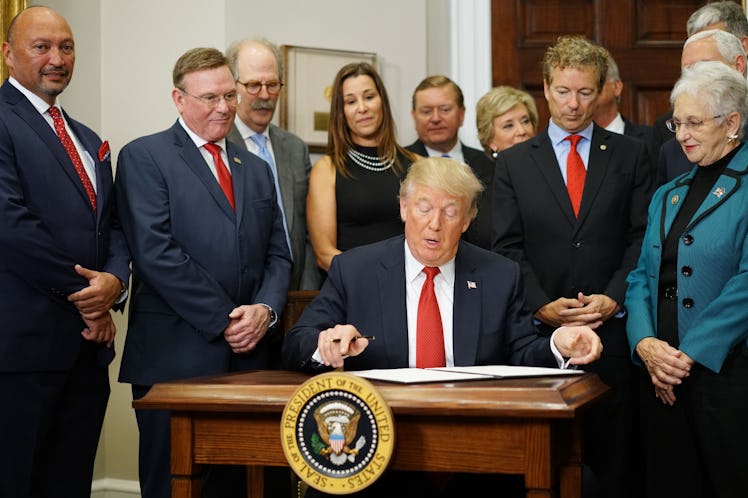
This Is What Trump's Health Care Executive Order Actually Does
President Donald Trump signed an executive order on Thursday, Oct. 12 for a new health care proposal that is intended to repeal and replace the Affordable Care Act (ACA, aka Obamacare). With just a signature, Trump began dismantling the Obama administration health care system that Congress has tried and failed to replace for the past few months. The executive order is just the start of a long process to change America's health care system, so what does Trump's health care executive order do?
It's no secret that Trump has wanted to repeal Obamacare for awhile, calling it "a disaster" is his statement today. Trump referred to his health care plan as a "truly historic announcement" that's "going to be very, very powerful for our nation and very good for a lot of people."
His plan focuses on "association health plans," which aim to "help businesses help their workers," Trump said in the statement. This would allow small business owners and trade groups to buy health insurance and move "towards lower costs in the health care market," Trump said.
Shortly after Trump's executive order, the National Association of Insurance Commissioners (NAIC) released a statement of concern about "the impacts of such a proposal on already fragile markets."
According to Politico, Trump's plan would attract younger and healthier people — and leave elderly and sick people who have relied on Obamacare to pay higher costs.
This order also aims to provide more insurance options for Americans, as Trump claimed, "one-third of all counties have only a single insurer selling coverage." Trump's goal with the health care plan is to "increase competition, increase choice, and increase lower-priced, high quality health care options," adding that, "they will have so many options."
Another key part of the order is reversing the Obama-era restrictions on short-term health insurance plans. This new plan would once again allow insurance companies to sell "stopgap policies," which often exclude a patient's pre-existing conditions and mental health services, among other things. This short-term insurance could last up to a year. The purpose of short-term plans, according to Politico, is to lower premiums and provide more coverage options.
Trump went on to say,
Seven years ago Congressional Democrats broke the American health care system by forcing the Obamacare nightmare on the American people. It has been a nightmare. This will cost the U.S. government virtually nothing, and people will have great, great healthcare. When I say people, I mean by the millions and millions.
This health care plan that would cost "virtually nothing" is something that Trump says, "should've and could've been done a long time ago."
Trump highlighted competition with this health care plan, claiming that "insurance companies will be fighting to get everyone signed on," but the downside of this is could possibly be that insurance companies will value healthy, desirable Americans over people in need.
Cori Uccello, a senior health fellow for the American Academy of Actuaries, told Fox News, "If a goal is to provide protections for people with preexisting conditions, this is a step in the wrong direction."
Trump closed out the statement by making a nod to tax cuts in the future, saying,
Today is only the beginning. In the coming months, we plan to take new measures that will include massive tax cuts. The whole country is looking for these massive tax cuts and we will get them.
This executive order is just the start of a long process to "repeal and replace" Obamacare, but there will not be immediate changes. Trump said he intends to "pressure Congress to repeal Obamacare once and for all," which could take some time to actually implement. This health plan will likely cater to a certain group of Americans similar to how Obamacare did, but the hope is that we can slowly move towards compromise that benefits all people in need.